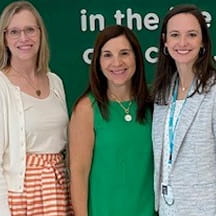Practical Solutions for Common Challenges in Clinical Coaching for New Graduate Pediatric Nurses

As the complexity of care required by pediatric patients has increased, new graduate nurses and the educators who train them have faced challenges in developing the clinical judgment skills necessary to provide confident, competent care.
In a webinar series hosted by Pediatric Learning Solutions, Mary Anne Jessee, Ph.D., RN, associate professor, assistant dean for academics, generalist nursing practice, Vanderbilt University School of Nursing, shared background and possible solutions for organizations to consider when revising their orientation processes to meet the needs of today’s new graduate nurses.
The first webinar in the series focused on exploring contributing factors and an algorithm that can be implemented at the organizational level to help educators, preceptors and supervisors foster clinical judgment in newly graduated nurses. Participants then shared questions and examples of the challenges their hospitals are facing. Jessee shared these challenges, broken down into four examples, along with proposed solutions in a follow-up webinar.
Problem 1: No time for clinical coaching in precepting
Preceptors often carry a full patient load on top of coaching learners throughout their shifts. This can leave little to no time at the end of their shifts for debriefing and promoting self-reflection within their orientees.
“This is a really common problem,” Jessee says. “Preceptors are already stretched with responsibilities and patient care. We cannot create more time, but we can make the best use of time that we have by considering how our preceptors and learners are interacting.”
Jessee suggested there are a number of things to look at that can help prevent cognitive overload and missed learning opportunities including:
- Consider how orientation currently runs.
- Note what preceptor duties cannot be changed (e.g., patient load, certain precepting tasks).
- Consider how orientation currently runs.
- Note what preceptor duties cannot be changed (e.g., patient load, certain precepting tasks).
- Look at integrating specific processes into the preceptor's duties rather than expecting them to remember each task on their own.
“What are the ways that [educators] can support preceptor preparation? And then what are ways within that we can empower the student to take on some of the responsibility for questioning within the clinical coaching?” says Jessee.
These overarching questions set the foundation for solutions posed in problems 2-4.
Problem 2: Learners are task-focused and miss the big picture
With this challenge, Jessee noted that novice nurses often take a very task-focused approach to care delivery based on their level of knowledge, experience and comfort providing care. This can lead to missed learning opportunities and a lack of understanding of each patient situation.
“What we want is for that bigger picture to become the guiding or driving force for their implementation of nursing care,” Jessee says. “The most effective and efficient way to move them forward is to purposefully shift their thinking to the bigger picture with each patient situation.”
It can be challenging for preceptors to facilitate this shift while providing patient care, as changes in patient status can require them to step in when a task deviates from what a new graduate nurse expected.
“When a patient starts to decline, or there's a change in patient status, they get so thrown off that they can't refocus and get back on track,” says Kelly Rolle, BSN, RN residency coordinator, educator at Loma Linda University Children’s Hospital. “It’s hard for the preceptor to try to reel them back in, get them to refocus and reorganize their thoughts.”
Jessee suggested working “big picture thinking” prompts into existing tasks new graduate nurses are already expected to complete, such as adding a few questions into the patient documentation every nurse already fills out each shift. This allows learners to naturally connect with the “why” behind each task and builds in natural conversation points the preceptor can dive into when debriefing with learners.
Problem 3: Adjusting to complex patient care loads
Many organizations start their new graduate nurses with providing full care for one or more patients under the guidance of a preceptor, adding more patients over the learners’ orientation time. Starting learners off with all these responsibilities at once often leads to continued hyper-focus on a task-based mindset rather than allowing nurses to become fully comfortable with all areas of their job.
As an alternative, Jessee suggested concept-based experiences—both on the floor and in classroom environments—that allow learners to become comfortable and confident with specific aspects of the job progressively. For example, instead of providing complete care for one patient, they may start with a full load of three to four patients but only be responsible for assessing and completing documentation for those patients during the first few weeks of orientation.
“They get well versed in just a couple of days at recognizing expected and unexpected values in assessments in different contexts, and they get familiar with varying that documentation as needed based on those individual situations,” Jessee says. “All of their focus is on that particular element of care delivery, so we can focus their thinking on: ‘What is it that you found in this assessment? Which part of that is most meaningful in this situation? And what is it about that that will drive your care?’”
Once they are proficient in one area, learners would move on to tasks such as medication administration, more advanced skills such as g-tubes, tracheostomies and CLABSI prevention. Sherry Hernandez, MSN, RN, CPN, pediatric educator at University Children’s Health, assisted her organization in moving to a concept-based phased model of orientation for their PICU, intermediate care and acute care units.
“[Previously,] staff would come off [orientation], and they were safe and competent, but not necessarily PICU ready so we would always have to give them the lower acuity patients,” Hernandez says. “Now, when the nurses are coming off, they are more confident, competent, and the team themselves also feel that this nurse could take any patient in the unit.”
Problem 4: Failure to recognize or respond
The task-based focus and tendency to “freeze” when an unexpected change occurs can carry over to potential patient harm if a nurse is not able to respond quickly and appropriately. To address this throughout orientation, Jessee suggested adding the Structured PAUSE Method into preceptors’ strategies and learners’ education to aid in recognition of new data cues, analysis and response.
The PAUSE Method encourages nurses to:
- Pause
- Assess
- Understand the
- Situation (context)
- Execute a change – action
If safe for the patient, preceptors can guide learners through this process in the moment and help them work through the challenge. If not, preceptors are able to model the appropriate care to ensure the patient’s safety before debriefing. This method can also be employed in a simulation setting with less pressure on the learner. Jessee suggests implementing the PAUSE Method in both environments.
“When the learner has the opportunity to go through a few of these situations, whether simulated or actual, so they develop the opportunity or the ability to recognize the changes more quickly, that is, when this becomes most effective for them,” Jessee says. “[It’s] got to be an intentional act on their part to step back and think about it. That's why it's important that this be practiced with the preceptor.”
Christina Wilbur, MSN, MA, RN, NPD-BC, CPN, NPD practitioner at Ann and Robert H. Lurie Children's Hospital, said she would be adding this method to the “What if?” questions she encourages preceptors to ask learners when patient care is going as expected.
While the solutions to each problem mentioned in Jessee’s presentation are not direct solutions to the challenges new nurses are facing as they exit academia, they give hospitals and their educators tools to set new nurses up for success as they transition to providing patient care on the floor.
“I'm always asking, 'Can they provide safe, competent care at the end of the day?'” Wilbur says. “That's what we are trying to achieve.”
About PLS
Pediatric Learning Solutions’ online education provides the foundational knowledge clinicians need to master the competencies and skills for safe and effective patient care.


